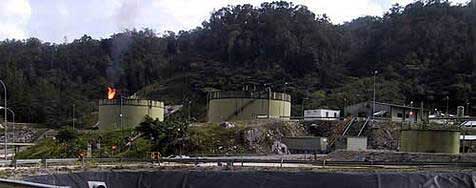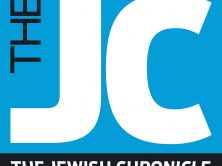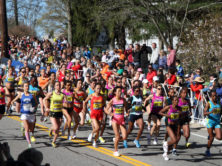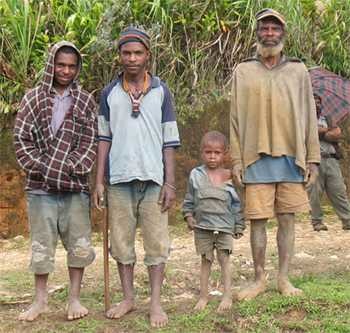
Henep Isum Mandingo, last on right. He is angry that Jared Diamond, reowned UCLA scientist, Pulitzer Prize winner and best-selling author, published "lies" about him in The New Yorker. StinkyJournalism sent three researchers into the Southern Highlands of Papua New Guinea (PNG) starting in July 2008 to fact-check Diamond's article, which ran a year ago today, in the April 21, 2008 issue of The New Yorker. We soon discovered that Henep Isum, an indigenous tribesman who was his main character, was NOT in a wheelchair with spinal paralysis as Diamond dramatically claimed. Yet Diamond wrongly published this error, as well as many others, including charging Daniel Wemp, the indigenous driver he used from the World Wildlife Fund (WWF) for his 2001-2002 bird research, with multiple crimes, including his assertion Wemp was a bloody warrior "thirsting" for revenge who personally paid for killers to do the "maiming of Isum." (credit: Michael Kigl, StinkyJournalism.org)
EXCLUSIVE : If Jared Diamond had changed the names of people and tribes and simply said that he was unsure if the stories he heard were true, Daniel Wemp, his single source for his tale of Papua New Guinea (PNG) tribal revenge, would not be in the danger that Diamond and his publisher, The New Yorker magazine, placed him in. This crisis was set in motion a year ago today, on April 21, 2008, with the publication in The New Yorker of the Pulitzer Prize-winning author and renowned UCLA scientist’s article, “Annals of Anthropology:Vengeance Is Ours: What can tribal societies tell us about our need to get even?”
When Papua New Guinea researcher Michael Kigl, working with StinkyJournalism, went to Daniel Wemp’s Nipa home in the Southern Highlands, in July 2008 to ask him about The New Yorker article, he was shocked. Wemp had no idea that he or people he mentioned to Diamond in random stories about tribal warfare back in 2001-2002, would be publicly named, and worse, erroneously linked to heinous crimes.
Despite Diamond’s claims, Wemp was no Handa tribal leader, nor was Henep Isum a violent leader of the Ombals. Isum isn’t even an Ombal tribesman; he is a Henep, hence, his full name: Henep Isum Mandingo (tribal name, first name, last name).
In addition to tracking down Daniel Wemp, we also found Henep Isum. When Kigl first saw him, Isum was carrying a large bag of dirt over his shoulder. It turned out that Mandingo never had a spinal cord injury resulting in his being a wheelchair-bound paralytic, the result—or so Diamond claimed—of an arrow attack by Wemp’s hired assassins.
NEWS HIGHLIGHTS:
- Daniel Wemp and Henep Isum file a summons and sue for 10 million dollars in the Supreme Court of the State of New York–charge famed UCLA scientist and best-selling author Jared Diamond and Advance Publications (aka The New Yorker magazine and Times-Picayune newspaper) with defamation, April 20, 2009.
- REVEALED: The New Yorker removed Diamond’s article from the open Internet last year after demand by Daniel Wemp’s lawyers (Lexis Nexis, EBSCO, Gale Group databases also complied with the take-down. Only abstracts remain).
- The New Yorker fact checkers never contacted any of the indigenous Papua New Guinea people named in Jared Diamond’s article as unrepentant killers, rapists and thieves, before publication.
- Henep Isum is not paralyzed in a wheelchair with a spinal injury, as Diamond claimed. He and Daniel Wemp, Diamond’s World Wildlife Fund driver in 2001-2002, and the only source for The New Yorker’s revenge story in Papua New Guinea, as well as dozens of tribal members and police officials, deny Diamond’s entire tale about the bloody Ombal and Handa war, calling it “untrue.”
- Expert linguistic analysis and The New Yorker’s own admissions indicate the quotations attributed to Daniel Wemp, as spoken in 2001-2002, are fabrications.
What did Jared Diamond’s fictional tale claim?
Diamond said that Daniel Wemp was a Chevron driver (untrue, he was a World Wildlife Fund [WWF] worker) who swapped stories with him during drives for his bird research. It was from the stories that Daniel told him on these trips that Diamond weaved his tale of two tribes, the Handa and Ombals, and their endless and futile violence based on a relentless “thirst” for revenge.
Diamond claims Wemp was the leader of a three-year effort to gain personal vengeance for the death of his beloved uncle Soll—who was only killed after an Ombal was angered when a Handa man’s pig wrecked his garden. In the six battles that he instigated, Diamond claims, Wemp tirelessly mustered and financially supported hundreds of warriors from 1992-1995, including providing comfort women for their sexual needs and stealing 300 pigs from enemies. All of this carnage and thievery, Diamond alleges, was brought about by Daniel Wemp’s obsessive “need to get even” for the death of his uncle Soll, who was destined to be a leader. Wemp selected Henep Isum, Diamond tells us, because he was the Ombal leader and counterpart. If Daniel Wemp’s assassins could kill Isum then his vindication and lust for revenge would be satisfied.

Here is photo of Daniel Wemp in his World Wildlife Fund office in 2001, the very year he was driving Dr. Diamond for his bird research and discussing PNG warfare.
Daniel and Isum both have confirmed that they never met each other before Diamond’s article was published. Thus, there were no dramatic apologies by Daniel shaking Isum’s hand at Handa /Ombal basketball games, as portrayed in Diamond’s article. Isum also said that he never spoke to anybody [meaning Diamond or The New Yorker]. He never gave consent to anyone to use his name or his story of how he was wounded or paralyzed in the tribal fight. He said that he had never spoken to Daniel Wemp on any occasion during or after the fights.In the end, after many failures and 30 people killed (a total of 47 killed, including 17 during the four years of fighting leading up to Soll’s death), Wemp finally triumphs and his killers manage to stick an arrow in Isum’s spine and paralyze him. Diamond claims Isum’s very public suffering as a wheelchair-bound paralytic for the past 11 years has made Wemp happy. He reports that Wemp even told Isum he was sorry. From the New Yorker article: “Occasionally, I go over to Isum, shake his hand, and tell him, ‘I feel sorry for you.’ But people see Isum. They know that he will be suffering all the rest of his life for having killed Soll. People remember that Isum used to be a tall and handsome man, destined to be a future leader. But so was my uncle Soll. By getting Isum paralyzed, I gained appropriate revenge for the killing of my tall and handsome uncle, who had been very good to me, and who would have become a leader.”
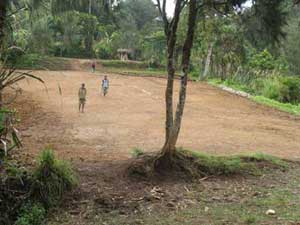 |
 |
|
Henep Isum Mandingo, shown here on the right, and in the distance, in the photo on the left, is obviously not confined to a wheelchair. He is a dignified man and former village peace officer. He stopped his hard physical labors of clearing land and carrying heavy sacks of dirt to pose for this image taken by iMediaEthicsteam member, and local researcher, Michael Kigl. Image taken, August 2008, at Isum’s home in Southern Highlands, PNG. |
|
Joseph Kuwimb Hal, former primary school teacher and currently business development officer (Isum is Hal’s uncle from his mother’s clan) said, “The whole story and the story of how he (Isum) got injured is an opposing view and not correct. The society, we are not happy, we totally condemn that report on the article.” (Translated)
Jared Diamond’s “pig in a garden” war is a fictional composite constructed from random stories Wemp said he had heard.
The only correct facts in the entire story are the names of Wemp and Isum (although incomplete—their full names are: Henep Isum Mandingo and Hup Daniel Wemp) and the names of the tribes, Handa and Ombal. Isum is not a warrior but a former village court peace officer, still serving his community by building a ceremonial area for feasts and celebrations. (See images above.)
In his article, Diamond attributes getting the names of Isum Henep, the brothers of Fukal Limbizu and Wiyo, Soll—all the information about these years—from Daniel Wemp during their long car drives together in 2001-2002. StinkyJournalism found out—and this was confirmed by The New Yorker—that the only notes Diamond actually took of their conversations were back dated. That is, four years after the drives in the car with Daniel Wemp, Diamond re-contacted his “source.” By that time (May 2006), Daniel Wemp had a new job as an oil field technician at the Oil Search Ltd. They met at the company’s compound dormitories (again, Wemp was not a Chevron employee, as Diamond reported; Chevron sold their stake to Oil Search in 2003).
Even though Diamond’s article says the quotations by Wemp were made in 2001-2002, this was untrue. The several long and complex (and erudite) quotations attributed to Wemp—that Wemp vehemently denies saying—were apparently composited together by Diamond into a single narrative, along with bits and pieces of Wemp’s stories Diamond remembered from years before. Diamond could have easily checked facts with the Ombal driver who still works for WWF, and presumably, also still picks him up at the Moro airport at WWF behest as a perk for Diamond serving as a WWF board member in the U.S. for many years.

Diamond is on the Board of Trustees for World Wildlife Fund, USA. and operates out of their Papua New Guinea office to obtain services, such as drivers, like Wemp. Why didn’t he ask the local WWF, to whom he uses to arrange transport to and from the Moro airport, to provide contact information for Wemp, who used to work there and everyone knows?
Let’s examine just one example of the seriousness of Diamond’s errors and how he jumbled facts: Wemp told Diamond he lives in Nipa/Kutubu district (his mother was Nipa, his father a sub-clan of Handa). Diamond’s untested assumption was that Ombals and the Handa tribes live in Nipa, since Wemp does. In fact, they live in a completely different district, Komo-Margarima. The more serious error occurs when Diamond extrapolates his false premise that “Ombals and Handas are Nipa and live in Nipa” to devastating effect when also assuming that the Ombals and Handa tribes also raped and killed Huli along with their fellow Nipa [sic] tribesmen on a highway in 1997.Wemp says, in one of dozens of phone interviews with StinkyJournalism since July 2008, “The facts are totally wrong in The New Yorker story. I have given all those stories to Diamond and those stories are very true and those names are not fake.” In other words, Wemp says he told the true stories to Diamond with real names but Diamond retold them wrongly by jumbling up information. By Diamond connecting false assertions of crimes to real people—all sourced to Wemp—he has put Daniel in danger among tribes, according to experts such as Dr. Nicole Clair Haley, Research Fellow, State, Society and Governance in Melanesia Project, Research School of Pacific and Asian Studies, Australian National University, who has worked in the Southern Highlands for 16 years.
Nicole Clair Haley explained by email and phone, after reviewing Diamond’s article and StinkyJournalism interviews with informants: “Part of the confusion seems to have stemmed from the fact that Daniel – a member of Handa-Hup sub-clan–grew up and had been living at Nipa, and not at Margarima where the groups involved in the fight are from. That Diamond describes the combatant groups as being from Nipa seems to demonstrate his confusion regarding the facts of this case.”
Haley continued, “The roadblocks and ambushes, to which he (Diamond) refers, took place on the Highland’s Highway following the 1997 General Elections and the Court of Disputed Returns proceedings. They concerned the provincial as opposed to the open seat. Perhaps even more importantly, though, the events described took place in and around Nipa and not in Magarima, where …the Ombal and Handa live…This is common knowledge in the Southern Highlands Province (SHP).”

The above political map shows that Nipa is far away from Margarima –the location where Ombals and Handa live and the place where the “2 Kina” fight actualy took place in 1993. See L.W Hanson, B.J. Allen, R.M Bourke and T. J. McCarthy (2001) Papua New Guinea Rural Development Handbook, The Australian National University, Canberra, pages 89-97. Also see: Allen, B. 2007. “The setting: land, economics and development in the Southern Highlands,” in Conflict and Resource Development in the Southern Highlands of Papua New Guinea, State, Society and Governance in Melanesia Studies in State and Society in the Pacific. Edited by N. Haley and R. J. May, pp. 35-46. Canberra: Australian National University E-Press.
One can easily understand that members of the Handa and Ombal are angry they have been labeled killers and rapists of Huli women by Diamond and The New Yorker—accusations that spread widely when the article was posted on the Internet—when they were actually victims of the conflict cited!
George Lek Kuwimb , a Handa, who is now a motor mechanic instructor at Nipa Technical College and is also related to the Ombals, told StinkyJournalism PNG researcher Kritoe Keleba, during an interview: “The Magarima people do no do road blocks. The Nipa people, yes, they do road blocks but not in relation to the fight but it may be related to political differences or other differences. But it does not involve our politics too. Our politics is clean (implying there no history of fights or lawlessness after a candidate from the area loose election).”
George’s brother, Mako John Kuwimb, a lawyer in PNG and a PhD candidate in law, living in Queensland, Australia wrote a 26-page analysis of Diamond’s article. He said, “The Handa and Ombal clans are located some 6-10 kilometres away from the road the Nipas blocked. This is to say that the Highlands Highway that connects and services the Nipa-Huli area is quite far from the Handa-Ombal territory for members of these clans to travel through other clans’ territory in order to block the roads.”
Kuwimb continued, “In fact, the blockade conducted by the Nipas against the Hulis resulted in looting and burning down of houses of people along the Highway on the Margarima side bordering Nipa. The raids were made by Nipas in their hot pursuit of the Hulis. Margarimas were innocent victims in this conflict.”
“It is an outrageous insult to say they were involved in raping women and violence on the highway. The Ombals and Handa are outraged by this false claim,” Kuwimb said.
Chock-A-Block errors
Diamond’s many other errors range from mistakenly saying that two villages are tribes (Aralinja and Ungupi are villages) to creating an entire history of conflict between two tribes where only the smallest fragments of truth can be found and then traced back to the seeds of real events that actually took place.
When Diamond writes of the “pig in a garden” fight that took place in Nipa for three years, 1992-1995, between the Ombal and Handa tribes—part of what he claimed was a history of never-ending fights between them—this can be related to the single and relatively small conflict between the Ombals and Handa for approximately 3 months of fighting in 1993, called the “2 Kina fight.” (Kina is the PNG national currency valued then at about $1 dollar)
Of the dozens of people our research team spoke with, everyone agrees uniformly on basic facts: 2 Kina went missing while five youths gambled in Mt. Hagen in 1993. The Handa youth punched a Solpaem youth. So the fight started between the Handa and the Solpaem. The Ombals were not in charge of the war that later broke out but served only as allies.
All Ombals and Handas—and independent parties, such as the police—whom we spoke with agreed. There was no “pig in a garden” fight between the Ombal and Handa tribes, nor were there six battles during the years 1992-1995. There were no 300 pigs “sacrificed” or stolen, and there were no 30 war dead, or 17 dead in the years before.
Phillip Pungiam, senior constable at the Nipa Police Station, described the outbreak of violence in 1993: “The Ombal reported that a ‘ Two Kina’ (2 K) incident occurred in Hagen (Provincial Headquarters of Western Highlands Province, a neighbor of Southern Highlands Province), where they (youths) were involved in gambling (card game)….A problem arose involving youths of Ombal and Handa. And they didn’t completely solve the problem in Hagen instead brought it back to the village.”
Constable Pungiam again confirmed, “They fought until … two men from Ombal side died and two from Handa died. They confirmed this and reported it at the police station. The Ombal reported the case to the police and at around the same time too, the Handa reported. Their stories were same.”
Isum told Kelaba that the ‘Two Kina Fight’ started in Hagen…played cards for one ‘Two Kina’ [a monetary unit equivalent to $1US]. They fought over this [card game, Queen] and brought the problem here and fight began over this two kina. The Handa and Ombal fought [each other].”
A Ombal group of 23 men told Kelaba the history of the fight as beginning with a Handa boy breaking the jaw of one of their own members. They said: “He (Song Sowal, the boy injured) is the son of Soal. And down there [Handa area] … Kor Ungurip [is] brother of Paul La’a, the boy who broke his jaw). They broke this (touching their jaws). We told them to pay compensation and said [the] boy (victim) was alive so why should they pay compensation. We asked them at least you [Handa] give us one pig …for the blood [loss of blood from the injury]. When they refused to pay (compensation); that is how the fight started. The reason of the fight is this [the refusal to pay compensation]. We do not get into trouble for other things. When they didn’t pay, we waited until our patience was exhausted and we [started the] fight.”
It is not surprising that all parties agree to the basic facts of the initial conflict, as it is fundamental to maintaining the settlement that was reached among the multiple tribes (led by the two sides of Handa and Solpaem). According to tribal law, everyone has to agree on the basic facts of what happened to whom and how much—and stick to that agreement—or a new fight could break out. Anyone who changes the narrative would be violating the tribes’agreement and corresponding money paid based upon complex negotiations of who was injured or killed and how badly and—not unlike an insurance company’s evaluation—how much money needs to be paid to victims and victims families after the fight.
Diamond’s uses names uncle Soll, Limbuzu and Wiyo—well known victims of 2K fight
The names Diamond’s uses of the dead and injured, although incomplete, lead us back in time to the single conflict that involved fighting between the Handas and Ombals. These two tribes had previously—absent the three to six month fight in 1993—a peaceful relationship.
We know that Diamond refers to facts taken from the real war, as his New Yorker article mentions Uncle Soll, Limbuzu and Wiyo, real people who were killed or injured in the 2 Kina fight. Other than these three names, the remainder of the facts that Diamond presents are untrue. Only Sande (Mogan Sande Hameno), an Ombal ally that Diamond does not mention, was killed hours after battle. The three others –Handa’s Ken Soll and Fukul Limbizu, and Ombal ally, Kekel Ambiak—were not killed in battle but wounded and died months later. No Ombals died in the 2K fight.
Soll was not a close relative of Handa sub-clan Hup Daniel Wemp (Soll was a Ken Handa sub-clansman), nor was Wemp involved in any part of the 3-month conflict; he was out of the village the entire time. It is worth noting that Wemp, who was depicted by Diamond as a seasoned and bloodthirsty warrior, had only picked up a bow and arrow once in his life, when he was a teenager. He is now in his late 30’s but would have been too young to have been “owner of the fight” in 1992 (as Diamond asserts), in his early 20’s. Sponsoring a fight is expensive and this literal accountability helps keep everyone in check. (If American generals had to personally pay for fights out of their own pockets, do you think there would be so much warfare? Upon reflection, this is a wise PNG strategy that helps retard violence).
Summary of Diamond’s fictional history about the Ombal / Handa conflicts
Diamond stated in his New Yorker article that the two Southern Highlands “Nipa” clans, the Handas and the Ombals, were in an endless cycle of violence that had raged for decades. As they were from Nipa, when a Nipa political election did not go their way, they started “blocking highways” and “killing Huli men they found in the vehicles and raping Huli women.” Another time, when a Handa-owned pig plundered an Ombal garden, the resulting six battles, which took place from 1992 to 1995, left 300 pigs “sacrificed” and 30 warriors dead, including Daniel Wemp’s Uncle Soll, who was killed in one of the battles. Diamond wrote “in the four years of fighting leading up to Soll’s death, seventeen other men had been killed.”
An amazing coincidence, indeed, that then 32-year-old Daniel Wemp, Diamond’s driver in 2001-2002, turned out to be a seasoned warrior whose expertise was fighting. Daniel, according to Diamond, served “with the brothers of Fukal Limbizu and of Wiyo” as the Handa leader who was official “owner of the fight” of the 1992-1995 Handa/Ombal war. When Daniel was 22, reported Diamond, he was a master of logistics who, over a three-year period, hired and then cared for hundreds of mercenaries from 14 tribes in his relentless “thirst” for revenge. Diamond wrote, “Hiring, supporting, and rewarding all those allies was a complex logistical operation. Daniel had to feed them during the actual days of combat, to arrange for houses in which they could sleep, and even, as he delicately phrased it, ‘to provide ladies for the warriors when they were homesick.’” As he sought and failed to gain revenge for his Uncle Soll’s death, over three years, he personally arranged to steal 300 pigs from his Ombal enemies, and did “incessant plotting” of murder of Henep Isum, the owner of the fight for the Ombals. Diamond wrote, “By accepting the official role known as ‘owner of the fight,’ Isum took responsibility for the killing.”
Diamond told his readers that if Daniel murdered Isum, he would “exact appropriate” revenge for his beloved Uncle Soll’s death. After many failures of “personally orchestrating the shooting of Isum,” Daniel’s hired assassins finally shot an arrow into Isum’s spine that caused him to be paralyzed. With revenge achieved, Daniel was, at last, satisfied. Time passed and Isum suffered publicly, for 11 years. As Isum sat in a wheelchair, Daniel would approach Isum during Handa/Ombal basketball games and tell him how sorry he felt. But inside he was “unapologetic” and filled with “exhilaration and pleasure in expressing aggression,” having committed revenge with his own efforts instead of leaving it to the government. In the end, Diamond reported, the personal cost was only a matter of money. Daniel had to pay, by age 25, “the man who shot the arrow that paralyzed Isum” a total of “eighty pigs plus fifteen thousand kina,” a value of approximately, $40,000 to $60,000.
Diamond used this story about Daniel’s satisfaction with his revenge as part of his statement of a general theory about revenge in cultures. He contrasted Daniel’s happiness resulting from “New Guineans traditionally practiced unchecked violence against each other” with his own father-in-law’s unhappiness, when in post-Nazi Europe, he chose not to take personal revenge against his family’s killers and lived to regret it.
If The New Yorker and Jared Diamond are seeking truth, why do they refuse to call Daniel Wemp or the others?
The only time that The New Yorker spoke to Daniel Wemp was on August 21, 2008, when an interview took place between Daniel Wemp and Chris Jennings, New Yorker’s fact checker. At the start of the interview, Jennings asked, “Are the stories in the article accurate? Is it true?” Daniel answered, “Not accurate, not accurate.” Later in the same interview, Daniel reasserts his stories are real but Diamond’s are not. Daniel said, “Those stories that I gave him, it is all those stories that I gave him are those true stories, what had happened, the real names of the people.”
Emails from The New Yorker and a transcript of the phone conversation on August 21, 2008 between Daniel and The New Yorker fact checker, Chris Jennings, confirm that Diamond conducted only a single interview with Daniel Wemp for which notes existed, on May 29, 2006, and that Daniel was the single source for the narrative and specific facts in the article.
Jennings admitted the whole article is built only on the notes from May 29, 2006. Speaking to Daniel on August 21, 2008, Jennings said, “He [Diamond] met you previously in 2001 and made your acquaintance. And the notes, which he uses for this story, tell the specific details and the quotations of you, were when he spoke to you on May 29, 2006. And then on [inaudible] May 29th of 2006. And he took very long notes. He, didn’t you know — he wrote them while talking to you. And when [inaudible] the story, it’s everything from what’s put in the article, it’s everything from what he wrote on that day with you.”
Jennings was, in all likelihood, not even working from Diamond’s original shorthand notes. He was reading Diamond’s translations from shorthand of the single interview from two years before (May 29, 2006), whose purpose was to simulate quotations and re-construct information supposedly supplied by Daniel Wemp in 2001-2002 while he worked as Diamond’s driver.
Daniel said that he and Diamond only discussed the Handa/Ombal conflict of 1993 a total of three times. The fact that Diamond took notes during only one interview with only one person, four years after their initial conversations in 2001-2002, is confirmed by Daniel. During two of the three or four times he was driving Professor Diamond for bird research forays during 2001-2002, no notes (or audio recordings) were taken. The third meeting, and the only time notes (no audio) were taken, on May 29, 2006, was also the final time Daniel heard from Diamond.
On May 28, 2006, the night before that final note-taking meeting, Daniel had received a note from an office receptionist that Dr. Diamond had called requesting to speak to him the following day (in the Oil Search camp, Wemp’s then job site) about the stories he’d told him four years before.
Here is the timeline for Daniel Wemp:
- 1999-2002—Worked at World Wildlife Fund (WWF) as driver and administrative worker (This is confirmed with WWF). He was assigned to drive Jared Diamond to and from the Moro airport. He drove Diamond and K. David Bishop, Diamond’s companion, on 3 or 4 bird research trips during the time he worked for WWF. He also said he spoke to Diamond about warfare on only two occasions while driving him for bird research.
- July 14, 2002 –Daniel Wemp resigned from WWF and was hired by Chevron as an oil field worker, process technician. (Confirmed with Oil Search). He never drove Diamond again.
- Summer 2003–Chevron was sold to Oil Search Ltd. Wemp became oil field worker for Oil Search Ltd.
- May 28, 2006 –– Daniel Wemp received a note on his desk from Diamond by his computer in the Oil Search Ltd office. The receptionist placed it there after getting a phone call from Diamond. The note said that Diamond wanted to come by the next morning to talk to him.
- May 29, 2006 — Diamond knocked on Daniel Wemp’s door (25A) at approximately 7:30 a.m. with K. David Bishop. They sat down in the area adjacent to Daniel’s room. Diamond had a red notebook and black pen and wrote in a “foreign” language Daniel could not read. (New Yorker lawyers later reveal it is “shorthand”). Diamond asked about the stories Daniel Wemp had told him more than four years earlier, in 2001-2002. Daniel was tired, having worked all night, and at 7:30 am he still had not slept. He was, therefore, impatient with the questions and flip with some of the answers. He assumed Diamond knew their talks were private and that the information he gave him was confidential due to its “sensitive” nature. During the two hours he spoke with Diamond that morning, Daniel can’t remember his interlocutor once telling him anything about a book. Daniel also stated he was never told about a journalism article in The New Yorker that would feature him and the other people he named. In fact, despite Diamond’s claim that Wemp clearly knew that the information he was providing would be published, two WWF drivers, Philip Kayape and Aloysius Pokaraija, who were present, confirm Wemp’s claim that he asked them to leave and go to their rooms as the discussion he was having with Diamond and Bishop was private. Indeed, Nancy Sullivan, an anthropologist who lives in PNG and speaks Tok Pisin, asked Phillip Kayape about the May 29, 2006 meeting among Diamond, Bishop and Wemp. She asked what happened, and Kayape responded in Tok Pisin, “Secret tok tok, yeah.”
- July 7, 2007 –Wemp Left Oil Search job
- April 21, 2008—Jared Diamond’s article appears in The New Yorker, both in print and on the Internet
- December 9, 2008- “Justice Deferred” by Jarvis DeBerry, The Times-Picayune, republished the defamatory claims cited in The New Yorker article— even after the owner was notified and complied with taking down the New Yorker article from its web site. . Both Times-Picayune and New Yorker are owned and published by Advance Publications.
Bill Kovach, founder of Committee for Concerned Journalists and co-author of seminal book The Elements Of Journalism, is considered one of the deans of journalism ethics. He made the following statement about The New Yorker in light of the Daniel Wemp case:
“I’ve read the material in the file you sent of your research on the article Vengeance Is Ours by Jared Diamond. It is an impressive file raising important questions both about the science and the journalism involved. Although you have made it possible for me to verify your work by careful attribution to sources, I have neither the ability nor the time to do that so I will limit my comments to what I know from reading the article as it appeared in The New Yorker and what I believe is the critical question a journalist reading the article for consideration to be published should have addressed.
“My comments are based on 50 years experience in newspaper journalism and on the journalistic values laid on in The Elements of Journalism, a book Tom Rosenstiel and I wrote in 2001, that is based in part on information accumulated over two years in open forums with more than 3,000 people including 300 journalists in which we asked them how journalism differs from other forms of communication and why the public should care whether journalism survives in the new world of unlimited instant communication.
“The first responsibility of the editor is to assure what the reader will see in the article is the truth. Therefore, the first reading would be to assure that the author’s assertions and conclusions have been authoritatively and clearly verified. In a case like this where the article was written by an award-winning scientist and presented under a subject head: “Annals of Anthropology,” the responsibility would be heightened since the reader should expect a careful, if not rigorously documented piece.
“Instead what was published is a complicated and in many ways confusing narrative based on what appear to be casual fragments of conversations in 2001 with a single source who claims to be an eyewitness. Around this single source narrative are woven assertions about what the social sciences tell us about such narratives. These fragments were knit together into notes taken later to produce the article that appeared in 2008.
“The narrator named a number of other participants in the event described that the author and the editor could have checked to verify the core narrative upon which the article was built. If such fact checking was done it is not made clear to the reader. A critical aspect of journalistic verification is transparency—what is made clear to the reader. Few people today are willing to, nor should they be asked to, accept undocumented assertions from journalists. If there are others involved in the story, their agreement or disagreement should be noted and dealt with.
“Thucydides warned all of us of the need for verification when he wrote of his own efforts to verify the history he wrote in the 5th century B.C.: “With regard to my factual reporting of events…I have made it a principle not to write down the first story that came my way…different eyewitnesses gave different accounts of the same events, speaking out of partiality for one side or the other, or else from imperfect memories.”
Were fake quotations attributed to Daniel?
Daniel informed The New Yorker that he was misquoted. In his interview with Jennings on August 21, 2008, Daniel said, “The words that I have spoken during that time I can’t actually remember what words I have spoken, all these notes that he has taken [inaudible] …but I see that the English [inaudible]…on the article is not good enough for such person like me [inaudible]. It is a perfect English which is written on the article.”
Jennings’ answered, “Okay. So, you think that the words may not sound like your own words.” Though Jennings heard Daniel, The New Yorker had no interest in this serious charge.
One of the four reasons I cited for initially doubting the veracity of Diamond’s article was that the quotations seemed fake.
The official national languages of Papua New Guinea are English and two pidgin languages (Tok Pisin, and Motu). Daniel Wemp’s first languages are Angal Heneng and Tok Pisin; but his English is fairly good. There were no tape recordings, as previously mentioned, and Daniel and Diamond both spoke in English. So any claims that Daniel has made that he has been misquoted cannot be brushed off as due to bad translations. Daniel had a 10th grade education at the time he first spoke with Diamond. Could Daniel, whose second language is English, really have spoken in the manner that Diamond has indicated in the following paragraphs? Diamond attributed to Daniel the following statements:
“That requires nerve, judgment, and presence of mind, to select the right target, and not to panic and shoot the first man who moves into a shootable position, he said. Boys and young men are prone to make such mistakes and hence are excluded from the stealth parties.”
Or this:
“Isum was in the public fight, with his bow and arrow ready for a long-range battle, and he was shooting and dodging arrows in the open. He was concentrating on that public fight, looking at our men far away in the open, and he wasn’t prepared for our attack from behind and nearby by one of our hidden parties. It was our group that had gone down along the side of the river that got him. Only one arrow hit Isum, but it was a bamboo arrow, flat and sharp as a knife, and it cut his spinal cord. That’s even better than killing him, because he’s now still alive today, 11 years later, paralyzed in a wheelchair, and maybe he’ll live for another ten years. People will see his constant suffering. Isum may be around for a long time, for people to see his suffering, and to be reminded that this happened to him as proper vengeance for his having killed my uncle Soll.”
Or this:
“I felt that it was a matter of ‘kill or else die by suicide.’ I was prepared to die myself in that fight. I knew that, if I did die then, I would be considered a hero and would be remembered. If I had personally seen the arrow go into Isum, I would have felt emotional relief then. Unfortunately, I wasn’t actually there to see it, but, when I heard that Isum had been paralyzed, I thought, I have everything, I feel as if I am developing wings, I feel as if I am about to fly off, and I am very happy. After that battle, just as after each battle in which we succeeded in killing an Ombal, we danced and celebrated and slaughtered pigs. When you fight with thinking and finally succeed, you feel good and relieved. The revenge relieves you; now it can be your turn to help someone else get his own revenge.”
The New Yorker and Jared Diamond deceived the public by falsely presenting statements supposedly said by Daniel on May 29, 2006 (which Daniel denies) as quotations of what Daniel supposedly said in 2001-2002, during three car rides. All the quotations in the New Yorker article are attributed to Daniel during car rides—none are attributed to his speaking at his workplace dormitory in 2006, at Oil Search Ltd. Oil Search is not mentioned.
Journalist, professor and media ethicist, Edward Wasserman, Knight Professor in journalism, Department of Journalism and Mass Communications, Washington and Lee University, stated, “I mean, if he [Diamond] has reconstitute[d] these conversations years later, then in The New Yorker, he had an obligation to indicate that much to the reader.”
Linguist Douglas Biber studied Daniel’s quotes and actual speech
I wrote to linguist Professor Douglas Biber, Northern Arizona University, Applied Linguistics Program, an expert on measuring the differences between written and spoken language. I asked, “With verbiage, such as ‘and hence…’ imbedded within long, numerous and supposedly spoken quotations, my common sense perspective was cued to doubt. My impression was that I am reading written English and not spoken English. The wordings seem too perfect and seemed to me what I recognize as written English word choices and sentence structures…Therefore, I seek more objective, forensic methods in order to determine by linguistic analysis whether or not the quotations as presented indicate written or spoken roots.”
Dr. Biber’s initial impression was that the quotations were academic writing, but he needed to do a final analysis to quantify it. On the phone, he said, “I don’t know any university professor that would talk like those quotations.”
He also wrote, “You’re certainly right that those quotes contain many grammatical characteristics that are typical of writing but rare in conversation.”
DESCRIPTION OF ‘CORPUS LINGUISTICS’ FIELD AND METHODS : Excerpted from Dr. Biber’s report:
“Over the last 25 years, a research approach has been developed for the empirical analysis of such grammatical characteristics. Referred to as ‘corpus linguistics’, the approach is based on the analysis of very large collections of natural texts from thousands of individual speakers and writers. Computer programs aid the analyses, which result in descriptions of the grammatical features that are especially frequent, features that are typical, and features that rarely occur. In addition, by comparing corpora with different kinds of texts, it is possible to contrast the grammatical characteristics that are usually found in conversation to those usually found in academic writing (or any other spoken or written varieties).

